

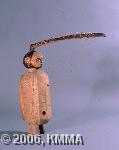
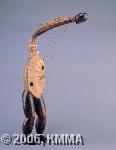
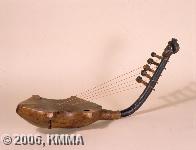
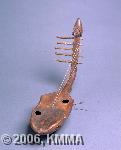
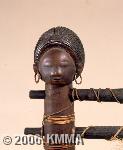
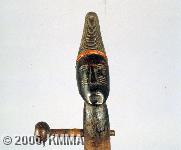

Possibly one of the most striking string instruments in Central Africa, because of its often exceptionally beautiful form and decoration, is the harp, which is represented in the north-east of the Congo by finely crafted examples from the Zande and Mangbetu, amongst others. The distribution of the harp exceeds the country’s borders and we also find examples in all kinds of shapes and sizes in the Central-African Republic, Gabon and Uganda.
The harp is characterised by several types of form and decoration. The very beautifully decorated examples are especially characterized by an extremely artistically engraved neck that is mostly crowned with an anthropomorphic head or, as in some other examples, by a complete human figure which functions as neck.
The three most important elements in this instrument are the neck, the sound box and the strings. The form of the sound box is particularly striking considering the different types which are still found today in Central Africa. In the north-east of the Congo alone there are already ten different harp types to be found. The simplest have an oval or rectangular sound box, with an animal skin stretched across it and a curved wooden neck attached to the sound box and to which the strings are fixed with tuning pegs.
The majority of all harp types have five strings, a characteristic which is in itself rather rare when an instrument is found in different music cultures, since uniformity is not always the rule.
Given its structure, the harp lends itself splendidly to use as an accompanying instrument for the singer–instrumentalist in the performance of songs on many different themes: history, narration, myth, genealogy etc.
We cannot however ignore two categories of harp which, considering their form and artistry, are clearly eye-catching, these being the Zande/Mangbetu and the large anthropomorphic harps of the Ngbaka.
The latter were found in the Lua basin and consist (as the name implies) of a human figure, where the body acts as a sound box with an antelope’s skin stretched over it. From the head comes a curved "neck" to which the strings are attached. A striking feature of several items in our collection is the eyes of inlaid mother of pearl and the heart-shaped head characteristic of Ngbaka sculpture.
A variant on this anthropomorphic model is the harp where the trunk and neck have the same function as in the previous type but are supplemented by a two-leg extension to the sound box upon which the instrument rests while being played. This harp is named seto after a human figure which regularly appears in their stories and fables. The harp illustrated here forms a couple with its male partner and is decorated with small strings of white pearls. Here too, its sound box and neck are two separate elements, where the neck, to which the five strings are attached, is fixed to its “trunk" by pushing it into an opening specially provided for it.
The instrument has a clear anthropomorphic character that is emphasised by the realistic representation of the legs, while the body and face are visualised in a more abstract way.
The most well known, appreciated and also most loved by experts and collectors of African harps, is the type that is played by the Zande and Mangbetu. Today the harps which are now still in use by these tribes no longer have quite the same kind of artistic attraction as those which were made and played in the past, and which now, for the greater part, are preserved in private and/or museum collections like the KMMA.
In the late 19th and early 20th centuries the first Europeans who crossed into the region collected some remarkable examples of kundi harps of the Zande. They all bear the same characteristics, such as the form of the sound box, the position of the tuning pegs and the typical sculpture of a head that crowns the neck and reveals its Zande origins. This last example stands out with its conical hairstyle, pierced ears and small pearls which accentuate the eyes. Another example, which we know was collected between 1910 and 1912 by the army captain A. Hutereau, gives us another impression of the artistry of the Zande sculptor, because of the way in which the hairstyle is reproduced.
More recent research has shown that establishing the differences between the Zande and the Mangbetu harp is not always that straightforward. This is also due to the fact that tribes culturally and politically linked to the Mangbetu, like the Mayogo, the Matchaga and the Mangbele, were themselves known for their harp building and possibly served as suppliers to and worked on projects for the Mangbetu chiefs. What became familiarly known as the Mangbetu harp, may in fact have been manufactured by another tribe "in the style of the Mangbetu".
The fact that the organological collection of the KMMA can boast musical instruments that are already more than a century old, is proven by a Nzakara harp which, although it was only incorporated into the collection in 1959, nevertheless originates from the 19th century. Baron V. de Crombrugghe de Looringhe bought the instrument in the Central-African Republic in 1894 and his son donated it to the Africa Museum in 1959. This instrument is a characteristic example of Nzakara art. The neck of the harp is crowned with a polished head, a rudimentary face without a mouth but with a typical hairstyle that takes the shape of an elongated and pointed helmet, the artistic trademark of Nzakara sculpture.
The most characteristic element of this type is the sculpted head that decorates the end of the neck and from which one can easily deduce the musical culture it originates from: Zande (hairstyle), Mangbetu (elongated head structure), Nzakara (helmet-shaped head).
In the oldest examples the tuning pegs have also been skilfully cut and the method of attaching the strings to the tuning peg merits attention. The way the string is tied to the tuning peg makes it fairly simple for the musician to tighten and tune it. Importantly, the tuning of the instrument, which is mostly pentatonic, can be changed according to the song one wishes to perform.
Finally, remarkable craftsmanship is shown in the very specific form of the sound box. A wet animal skin (snake, lizard, ostrich, antelope) is stretched across a wooden frame, tied down with string and allowed to dry. In this way the skins spans the whole wooden frame of the instrument and on some instruments there are still clear traces of the strings that stretched the skin.
The playing technique is found to be virtually identical throughout the entire area in which the harp is found. The harpist rests the sound box on his knees so that the strings are slanted towards him and he plucks the strings with the fingers of both hands.
This type of instrument is used in recordings of our sound archives made with the Congolese peoples mentioned hereafter where it appears with the following vernacular names:
Adungu (Lugbara), Bonguma (Balendu), Djoma (Lendu), Domo (Pygmées), Domu (Efe, Nyari), Kidongo (ndongo) (Hema), Kokoro (Ngbaka), Kundi (Gbandi, Zande), Kundu (Ngbaka), Lunkombe (Luba, Songye), Ngombi (Ngbaka), Nzanginza (Zande), Nzenze (Pygmées), Tomi (Ndo), Tomi (Domu) (Mangbetu)
Discography:
© KMMA